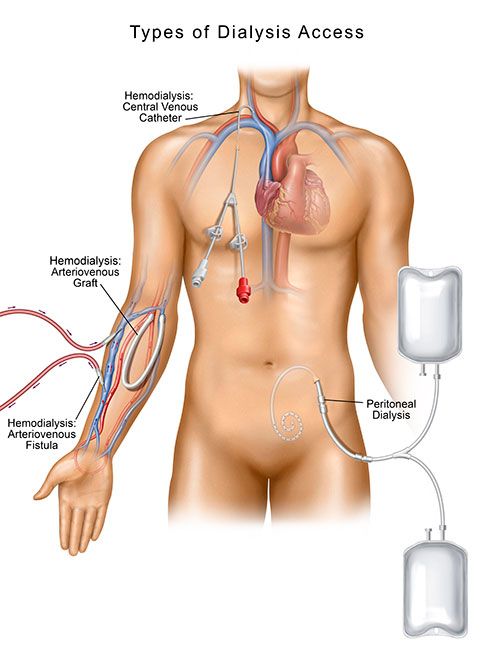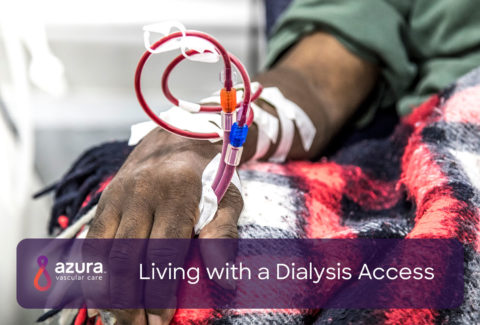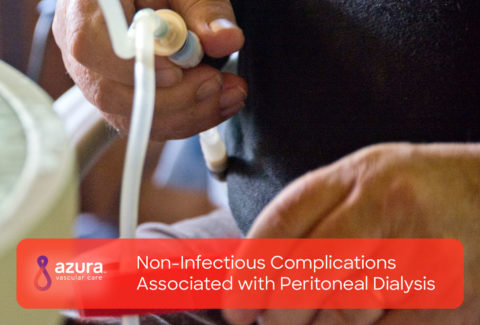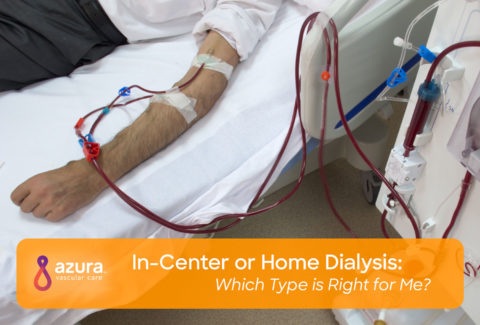
Beginning dialysis can be stressful and overwhelming. If you need to start dialysis soon, you have many decisions to make. Where you will receive your dialysis treatments is one of them. Options for dialysis treatment are in-center or home dialysis and for many, home can be the ideal choice.
If you’re interested in home dialysis, it’s essential that you understand all it entails. You need to learn to take care of your dialysis access. Remember, your access is your lifeline because it ensures you can receive your lifesaving dialysis treatments without interruption. Read on to learn more about home hemodialysis and caring for your access.
What Is Home Dialysis?
For the millions of patients in the U.S. who need dialysis each year, many do receive in-center treatment three times per week in a dialysis center. Dialysis centers are staffed with physicians, nurses and technicians who are specifically trained in chronic kidney disease and make up your dialysis care team. Some dialysis patients feel more comfortable receiving expert care in-center during their dialysis treatments.
In-center dialysis has its disadvantages. Patients must spend time traveling to the center for treatments which are usually performed three times a week with each session lasting 3 to 4 hours, and some may take even longer. [i] In-center dialysis patients must follow a restrictive diet between hemodialysis sessions and strictly limit fluid intake because treatments are administered three times weekly, which is less frequent than what a home dialysis patient may experience.
Home dialysis is different and can be an ideal option for many patients. This type of treatment allows you to receive dialysis in the comfort and privacy of your own home. There’s no need to set aside hours of travel time. Instead, you can perform dialysis treatments on your own schedule where you are not exposed to other patients who may be sick. Home dialysis patients may have fewer dietary restrictions when it comes to drinking fluids and eating certain foods.
What Are My Options for Receiving Home Dialysis?
If you opt for home dialysis, you still have some choices to make. There are several different home dialysis options, each with their own advantages. The first thing you’ll need to consider is whether you prefer hemodialysis or peritoneal dialysis (PD). [i]
Home hemodialysis works in much the same way as in-center dialysis. During hemodialysis, your blood is passed through a machine that removes excess fluid and waste products. PD is different. This type of dialysis doesn’t directly access your blood. To perform a PD treatment, you instill dialysis solution, also known as dialysate, through a catheter into your abdomen. The fluid remains inside your body for a prescribed period of time and then is drained out through the catheter into a collection bag. Some forms of PD use a machine to help cycle this fluid through your body. [iii]
The 3 types of home dialysis
- Conventional home hemodialysis can also be time-consuming. Like in-center dialysis, treatments are performed at least three times a week. They usually take several hours to complete. [i]
- Short daily home hemodialysis is usually performed five to seven times a week for two hours at a time. This type of home hemodialysis provides frequent dialysis treatments to reduce the amount of fluid and waste products that builds up in your blood. You may experience fewer headaches and less nausea after your treatments. [i]
- Nocturnal home hemodialysis treatments take many hours to complete but they’re performed while you’re asleep. In most cases, you perform your treatments three to six nights a week. Treatments usually last six to eight hours. Because you sleep through your treatments, they may seem less time-consuming. [i]
An exchange is the three-part process of 1) filling your abdomen with the cleansing fluid, 2) allowing the fluid to dwell inside your abdomen for a prescribed amount of time for removal of waste products and extra fluid, and 3) draining the dialysate from your body.
CAPD can take place away from home. During CAPD treatments, you can go about your normal activities. You can even perform your PD treatments at work, on vacation, or in any clean location. [iii]
Continuous cycling peritoneal dialysis (CCPD) uses a machine to cycle dialysis solution into and out of your body while you sleep. Many dialysis patients prefer their treatments at night, but with this type of dialysis, you remain connected to the machine for 10 to 12 hours each night. Some people may find this inconvenient. [iii]
Choosing an Access for Home Dialysis Therapy
Your medical team can help you select the type of dialysis that best meets your needs. Once you’ve chosen your dialysis method, you’ll need to have an access placed. Your access is the lifeline that allows you to receive regular dialysis treatments. There are several different types of accesses.
If you opt for PD, you will need to have a PD catheter placed into your abdomen. [iv] If you prefer hemodialysis, you will need to have a graft, fistula, or catheter placed. [v] No matter which type of access you receive, you need to take excellent care of your access at home for best results. An access infection or clotted access can interfere with your dialysis treatments and may lead to additional complications.
How Do I Care for My Access?
Here are some care tips for an AV fistula, AV graft or PD catheter: [vi]
- Keep your access clean and dry. After you shower or bathe, dry the hemodialysis access area right away. If you have opted for PD, you will need to keep the PD catheter site covered and dry at all times, showers should be avoided. Bathing is best achieved by using sponge baths.
- Cleanse the access area every day. Follow your dialysis team’s directions for keeping this area clean.
- Check your access area daily for signs of infection. Report any new symptoms to your care team.
- Wash your hands before you touch the access area. Have your caregivers or helpers wash their hands, too.
- Try not to pick or scratch at your access or the skin around your access site. Aside from dialysis treatments or daily cleansing, try to avoid touching your access area.
- Specific to an AV fistula or AV graft, avoid tight-fitting or restrictive clothing or jewelry. Choose loose-fitting, comfortable clothing in breathable materials like cotton.
- Specific to a PD catheter, use a sterile technique whenever removing the protective end cap from your catheter to instill or drain the dialysate solution.
What Are Some Signs I Need to See A Doctor?
Most catheter complications are caused by infections. Symptoms of an access infection can include: [vii]
- Pus draining from the access.
- Red streaks around the access area.
- Red, inflamed skin.
- Swelling, warmth, or increased pain.
- Fever
- Difficulty with filling or draining dialysate into or out of the peritoneal space.
Other signs of dialysis access complications may include:
- Bleeding,
- Bruising,
- Redness,
- Drainage or oozing at the access site,
- A change in the thrill or bruit of a hemodialysis access.
What Should I Do If I Suspect a Complication?
Report new or worsening symptoms to your medical team right away. Remember that home dialysis isn’t for everyone. If you’re struggling to manage your dialysis access or treatments at home, it may be time to reconsider in-center dialysis. Your medical team can help you decide which treatments options are best for you.
Would you like to know more about the different types of dialysis accesses? Azura Vascular Care can help. Download our free information sheet, Understanding Your Dialysis Access. Then call 866.996.9729 to schedule an appointment with a vascular specialist today.
Sources:
i National Kidney Foundation. (2015). Home hemodialysis. Retrieved February 20, 2019, from https://www.kidney.org/atoz/content/homehemo
ii Fresenius Kidney Care. What is dialysis? Retrieved February 20, 2019, from https://www.freseniuskidneycare.com/ckd-treatment/what-is-dialysis
iii Mayo Clinic. (2018, March 22). Peritoneal dialysis. Retrieved February 20, 2019, from https://www.mayoclinic.org/tests-procedures/peritoneal-dialysis/about/pac-20384725
iv Fresenius Kidney Care. Getting a peritoneal dialysis catheter. Retrieved February 20, 2019, from https://www.freseniuskidneycare.com/ckd-treatment/home-peritoneal-dialysis/pd-access#tabs
v National Kidney Foundation. (2015). Hemodialysis access. Retrieved February 20, 2019, from https://www.kidney.org/atoz/content/hemoaccess
vi Berns, J. (2017, August 22). Patient education: Hemodialysis (Beyond the Basics). In Steve Schwab (Ed.), UpToDate. Retrieved February 20, 2019, from https://www.uptodate.com/contents/hemodialysis-beyond-the-basics
vii National Kidney Foundation. (2015). Hemodialysis catheters: How to keep yours working well. Retrieved February 20, 2019, from https://www.kidney.org/atoz/content/hemocatheter



